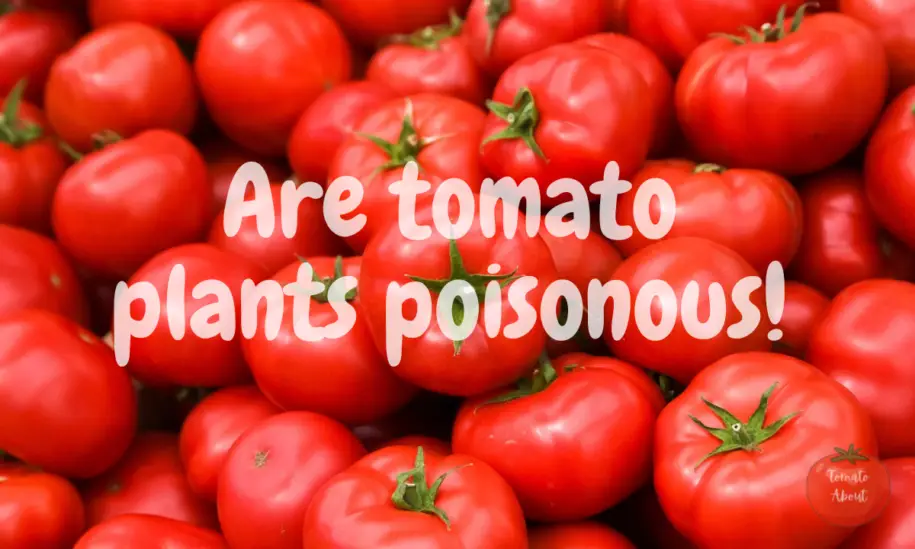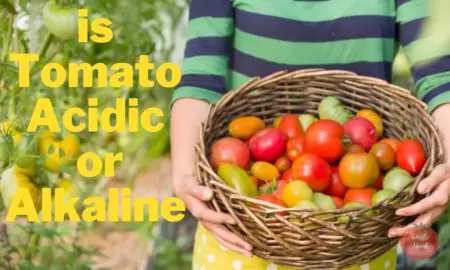Eating a garden-fresh, juicy tomato on a hot summer day is one of life’s simple pleasures. However, some people worry that tomato plants themselves may be toxic. With their status as members of the nightshade family, it’s natural to wonder – are tomato plants poisonous?
Contrary to popular belief, tomato plants are not poisonous. In fact, the leaves, stems and unripe fruit of tomato plants contain only trace amounts of the alkaloid compounds found in significant quantities in other nightshades.
While tomato plant parts are technically edible, they may cause gastrointestinal distress if consumed in excess. However, under normal conditions, tomato plants present minimal toxicity risk to humans or animals.
Why Are Tomatoes Classified As Nightshades?
Tomatoes belong to the plant family Solanaceae, more commonly known as nightshades. This broad category encompasses over 2,000 diverse species, many of which are important agricultural crops like potatoes, eggplants, peppers, and tobacco.
Several edible nightshades, such as tomatoes, contain glycoalkaloids – naturally occurring chemical compounds found in the leaves, stems, and unripe fruits. At high concentrations, glycoalkaloids can be toxic to humans.
This has led to the prevalent myth that nightshades like tomatoes are poisonous. But the glycoalkaloid levels in tomato foliage and green tomatoes are very low compared to other nightshade species. Ripe tomatoes contain hardly any glycoalkaloids at all.
Here’s how the glycoalkaloid concentrations in various nightshade species compare:
- Potato leaves and shoots: 200-5000 mg/kg
- Tomato leaves and stems: Generally below 200 mg/kg
- Eggplant leaves and shoots: Typically 100-400 mg/kg
- Ripe tomato fruit: Less than 10 mg/kg
As you can see, the quantity of potentially harmful glycoalkaloids in tomato plant parts is minuscule compared to closely related species like potatoes. This explains why tomatoes have a reputation as a non-toxic nightshade.
Are Tomato Leaves and Stems Edible?
While tomato plants are not poisonous, the leaves and stems do contain small amounts of solanine and other glycoalkaloids. Consuming substantial quantities of these plant parts could result in vomiting, diarrhea, headache, or drowsiness.
But occasionally eating a tomato leaf or two is not considered dangerous. Some people even use young tomato leaves and shoots in salads, or cook them like spinach. The glycoalkaloid concentration decreases as the plant grows.
Tomato leaves and stems are full of beneficial nutrients and antioxidants like niacin, riboflavin, thiamine, and beta-carotene. However due to the slight toxicity risk, most experts advise against eating significant quantities of foliage from tomato plants or any nightshade species.
What About Green Tomatoes: Poisonous or Safe?
Green, unripe tomatoes also contain trace amounts of alkaloids that give them a bitter taste. Eating a few green cherry tomatoes from the vine is not hazardous for most people. But ingesting pounds of unripe tomatoes could cause problems.
Some signs of possible glycoalkaloid poisoning from green tomatoes include:
- Nausea, vomiting, diarrhea
- Abdominal cramps, dizziness
- Headache, fever, lethargy
Once tomatoes turn red, the alkaloid content drops to very low levels. So fully ripened tomatoes, whether store-bought or homegrown, are not poisonous. But it’s still wise to avoid consuming unripe green tomatoes in large quantities.
Do Tomatoes Belong in a Poisonous Plant Garden?
Certain gardens intentionally grow poisonous plants ranging from deadly nightshade and hemlock to castor beans and monkshood. This can be risky with small children or pets around.
But tomato plants are one nightshade species that can safely be incorporated in any backyard garden. The small amounts of glycoalkaloids in tomatoes make them essentially non-toxic under normal conditions. Just be sure to ripen your tomatoes fully before eating them.
What About Tomato Allergies?
Some individuals may be allergic to tomatoes. Tomato allergy symptoms are generally mild, including:
- Itchy mouth or throat
- Hives, skin rash
- Stomach pain, diarrhea
- Runny nose
These reactions are not caused by toxins, but rather an overactive immune response triggered by proteins found naturally in tomatoes. Cooking or processing tomatoes can help reduce allergy risk.
Up to 2.5% of children and 1.5% of adults report tomato allergies. While uncomfortable, tomato allergies are rarely life-threatening. Strict avoidance is the only way to prevent symptoms in those with a confirmed tomato allergy.
Can Dogs, Cats, and Other Pets Eat Tomatoes?
Pet owners also frequently wonder, “Can my dog/cat eat tomatoes?” The answer is yes – ripe tomatoes are non-toxic for dogs, cats, and other domestic pets when eaten in moderation. Many pets enjoy munching on cherry tomatoes as a tasty treat.
However, cats and dogs should not eat significant amounts of green tomatoes, foliage or plant stems. The small amounts of alkaloids could lead to gastrointestinal issues. Introduce ripe tomatoes slowly and monitor your pet for any digestive upset.
Poisonous Tomato Look-Alikes to Avoid
When foraging for wild edible plants, it’s important to properly identify tomato relatives and avoid look-alike species. Here are a few poisonous plants that people sometimes confuse with tomato plants:
Deadly Nightshade
This dangerous European perennial herb looks almost identical to tomato plants. All parts of Deadly Nightshade contain high concentrations of tropane alkaloids like atropine, scopolamine, and hyoscyamine. Even small amounts could be lethal, causing respiratory failure.
Jerusalem Cherry
A small ornamental houseplant, Jerusalem cherry bears fruits that look just like mini tomatoes. But these “tomatoes” are toxic, containing solanine glycoalkaloids. Ingesting the fruits, leaves or stems can cause serious gastrointestinal and neurological effects.
Bittersweet Nightshade
Often called “woody nightshade”, this relative of tomatoes produces clusters of bright red berries. They may look tempting, but contain solanine alkaloids that can cause digestive problems, dizziness, confusion, and rapid heartbeat, even in small doses.
Horse Nettle
This wild plant produces small yellow fruit enclosed in protective spines. Though the toxic berries resemble tiny tomatoes, do not eat them! Horse nettle contains cholesterol-inhibiting glycoalkaloids that can lead to neurological issues and death if consumed.
Are Heirloom Tomatoes More Poisonous Than Hybrids?
Some claim that heirloom tomato varieties are more toxic than modern hybrids. This is false – there is no evidence that heirlooms contain higher glycoalkaloid levels. Tomato breeding has focused on enhancing productivity, disease resistance, color and flavor – not eliminating natural alkaloids. Both heirloom and hybrid tomatoes are safe to eat when ripe.
Can You Use Tomato Leaves in Cooking Safely?
Again, it’s best to avoid eating significant amounts of tomato plant foliage. But tomato leaves are occasionally used as flavoring in some ethnic dishes when cooked properly.
The heat from cooking helps deactivate the alkaloids, especially if you pour off the cooking water. Still, only use tomato leaves sparingly for flavor, not as a leafy green vegetable. And don’t give cooked tomato leaves to pets due to their sensitivity.
Gardening Precautions Around Tomato Plants
While tomato plants don’t pose serious poisoning risks, gardeners should still take some basic precautions:
- Monitor for pest damage, which can concentrate alkaloids in leaves
- Avoid cultivating tobacco near your tomatoes
- Wash hands thoroughly after handling plants and foliage
- Keep tomatoes picked as they ripen to prevent animals from eating green tomatoes
- Teach children not to put any plant parts in their mouth without checking first
Simple preventative measures like these make growing tomato plants safe and enjoyable for the whole family.
Can You Turn Poisonous Tomato Leaves into Tea?
Some sources claim you can dry and brew tomato leaves into an herbal tea. However, this is not recommended.
Tomato leaf tea contains variable amounts of alkaloids that could cause side effects like dizziness, headache, or nausea if consumed regularly. Occasional use may be safe, but tomato leaves are not a traditional folk remedy and have no proven health benefits when ingested as a tea.
Frequently Asked Questions
Are tomato plants poisonous to humans?
No. Tomato plants contain only trace amounts of potentially harmful glycoalkaloids. Consuming large quantities of green tomatoes or plant parts could cause minor stomach upset. But tomato plants are not toxic to humans under normal conditions.
What makes tomatoes part of the nightshade family?
Tomatoes belong to the Solanaceae or nightshade plant family because they contain glycoalkaloids – naturally occurring compounds also found in potatoes, eggplants, and peppers. Only ripe tomato fruits are very low in these alkaloids.
Can you safely eat tomato leaves if cooked thoroughly?
It’s best to avoid eating significant amounts of tomato foliage, whether raw or cooked. Cooking reduces but does not eliminate the glycoalkaloids. Occasional use of a few leaves may be safe, but they have no proven nutritional benefits.


